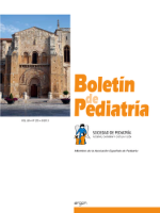La alimentación complementaria del lactante: recomendaciones existentes en el Área V de Asturias
M.F. García Díaz , V. García González , J.M. Fernández Menéndez , E. Lombraña Álvarez , L. Calle Miguel
Bol. Pediatr. 2013; 53 (225): 156 - 163
Introducción. Las recomendaciones de la introducción de la alimentación complementaria del lactante han ido sufriendo modificaciones. Hay una percepción subjetiva de que no existe consenso entre los profesionales en cuanto a las recomendaciones dadas a los padres para la introducción de los distintos alimentos. Objetivo. Conocer las pautas de alimentación dadas en los centros de salud del Área V de Asturias. Material y métodos. Estudio descriptivo transversal. Se recogieron y analizaron las hojas de recomendaciones de la alimentación complementaria que reciben los padres en los centros del Área. Las variables analizadas fueron la edad de introducción de cereal, fruta, leche de continuación, verdura, carne, pescado, huevo, legumbres, y lácteos. Para el análisis estadístico se calculó la frecuencia absoluta, relativa y porcentaje. Resultados. Sólo el 15,4% de los centros aconsejan iniciar el gluten a partir de los 4 meses en niños que reciben lactancia materna. El 30,8% de los centros no desaconsejan verduras potencialmente metahemoglobinizantes al introducir el puré de verduras. El pescado blanco se introduce en el 15,3% de centros al 8º mes, 38,5% al 9º, 38,5% al 10º y 7,7% al 11º. La yema de huevo, el 7,7% de los centros al 8º mes, el 23,1% al 9º, 23,1% al 10º y 46,1% al 11ºmes. La leche de vaca se introduce en el 7,7% de los centros al 12º mes, 7,7% entre 15º-18º, 53,8% a los 18 meses y el 30,8% no menciona cuándo debe introducirse. Conclusiones El estudio muestra una llamativa disparidad en la introducción de los alimentos entre los distintos centros. Especialmente variable resulta la edad de introducción del pescado, yema de huevo y lácteos. Solamente dos centros diferencian la edad de introducción del gluten, dependiendo del tipo de lactancia. Algunos centros introducen verduras metahemoglobinizantes al inicio del puré.
Complementary feeding of the infant: recommendations existing in Area V of Asturias (Spain)
Introduction.
Recommendations regarding the introduction of complementary feeding for the infant has been changing. There is a subjective perception that consensus does not exist among the professionals regarding the recommendations given to the parents for introduction of different foods.
Objective.
To know the feeding guidelines given in the Area V health care centers of Asturias.
Material and methods.
A descriptive, cross-sectional study was performed. Recommendation sheets on complementary feedings received by the parents in the Area centers were collected and analyzed. The variables analyzed were age of introduction of cereal, fruit, continuation milk, vegetable, meat, fish, egg, vegetables and dairy products. Absolute and relative frequency and percentage were calculated for the statistical analysis.
Results.
Only 15.4% of the centers recommend initiating gluten after 4 months in children who are breast feed. A total of 30.8% of the centers do not recommend against potentially metahemoglobin-forming vegetables when vegetable pure is introduced. White fish is introduced in 15.3% of the sites in the 8 th month, 38.5% in the 9th, 38.5% in the 10th and 7.7% in the 11 th month. Egg yolk is introduced in 7.7% of the centers in the 8 th months, 23.1% in the 9th, 23,1% in the 10th and 46.1% in the 11 th month. Cow milk is introduced in 7.7% of the centers in the 12 th month, 7.7% between the 15th and 18 th, 53.8% at 18 months and 30.8% do not mention when it should be introduced.
Conclusions.
The study shows a striking disagreement in the introduction of foods among the different centers. Age of introduction of fish, egg yolk and dairy products is especially different. Only two centers have differences regarding age of introduction of gluten, depending on type of breast feeding. Some centers introduce metahemoglobinproducing vegetables at the beginning of the pure.
Artículo completo (PDF) (102 kb.)
- Gastroenterología
